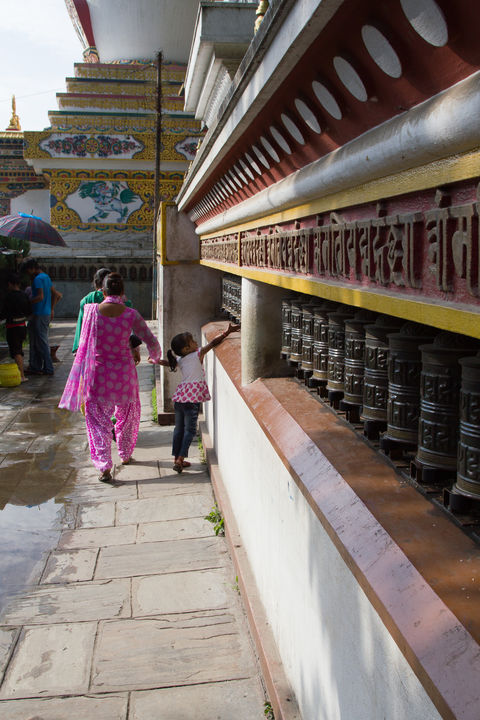Swayambhunath
Kathmandu, Nepal
The scene at the foot of the eastern staircase at Swayambhunath can only inadequately be described as 'chaotic'. Trays of butter lamps, lit and unlit, littered the base of the stairs. Vendors, pilgrims - most of them women, many wearing their best red saris for the Teej festival – monks, mendicants and monkeys jostled for space, while across the street, more visitors arrived continuously by bus, taxi or on foot.
On either side of the entrance, the whitewashed walls that run around the base of the hill are lined with prayer wheels, upright bronze cylinders about a foot tall, filled with scriptures and equipped with projecting handles to make it easier for the worshippers to spin them as they walk past. Each revolution of the wheel sends some specified number of prayers heavenwards. At intervals, the line of small wheels is broken by a doorway opening onto a small room housing a mani dongkor, a giant version of the smaller wheels seven or eight feet tall. People following the line of the hill would disappear into these rooms, complete a few brisk clockwise circuits of the turning wheel, and then emerge again like pinballs shot from a machine.
The stairs leading up from the eastern entrance to the top of the hill are flanked by statues of animals such as lions and elephants, and even a couple of rather fine Garudas - syncretic transfers from Hindu mythology to Tibetan Buddhism. The steps are steep but shaded, dominated by the gold spire of the stupa at the top.
The sacred precinct surrounding the huge whitewashed stupa at the top of the hill reproduced the chaos at the foot of the stairs, but this time with an added sense of purpose. The precinct contains perhaps a dozen shrines and temples, dedicated to various Buddhas, Buddhist principles, historical supporters, and even a Hindu goddess, Hariti the goddess of smallpox and fertility (plus two small cafes, sundry administrative offices, and a handful of shops selling handicrafts, including one that optimistically still offered Kodak film). The people here seemed to know where they wanted to go, heading directly for this or that shrine to perform their devotions, or pacing around the stupa, spinning the prayer wheels that ring the base.
For all the site's religious importance, there seemed to be no sharp division between the sacred and the profane. Inside one shrine, where trays of flickering butter lamps gave off a wave of heat that could be felt several feet away, people snapped photos of the murals on their mobile phones. A group of young women in their best saris lined up by the railing for a group photo, while other pilgrims simply stared out over Kathmandu, already starting to become indistinct in the growing heat of the morning.
In the midst of the almost medievally intense scenes of devotion, the business of the shrine went on. Overhead, two young men were busily engaged in giving the dome of the stupa a fresh coat of paint, one pouring the whitewash from a bucket, his partner wielding an immense brush made from a long bamboo pole tipped with a length of rag. A man wearing a transparent plastic glove on one hand sat among the monuments, giving one of the myriad stray dogs that lolled around the precinct its regular health check. A pair of monkeys perched on a lintel above the bustle groomed each other industriously.
Above it all, the stylized eyes of the Buddha, painted on each side of the spire that crowns the stupa, looked out over the throng of pilgrims and the hazy expanse of the city below.
